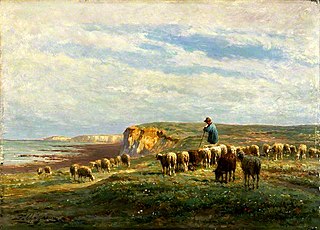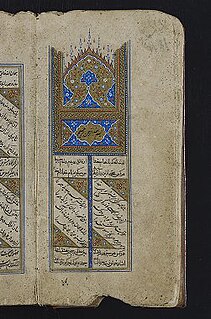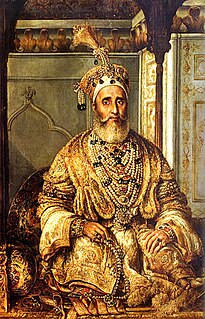
Poetry is a form of literature that uses aesthetic and rhythmic qualities of language—such as phonaesthetics, sound symbolism, and metre—to evoke meanings in addition to, or in place of, the prosaic ostensible meaning.
The pantoum is a poetic form derived from the pantun, a Malay verse form: specifically from the pantun berkait, a series of interwoven quatrains.

A sonnet is a poem in a specific form which originated in Italy; Giacomo da Lentini is credited with its invention.
A sestina is a fixed verse form consisting of six stanzas of six lines each, normally followed by a three-line envoi. The words that end each line of the first stanza are used as line endings in each of the following stanzas, rotated in a set pattern.

A villanelle, also known as villanesque, is a nineteen-line poetic form consisting of five tercets followed by a quatrain. There are two refrains and two repeating rhymes, with the first and third line of the first tercet repeated alternately until the last stanza, which includes both repeated lines. The villanelle is an example of a fixed verse form. The word derives from Latin, then Italian, and is related to the initial subject of the form being the pastoral.
A limerick is a form of verse, usually humorous and frequently rude, in five-line, predominantly anapestic meter with a strict rhyme scheme of AABBA, in which the first, second and fifth line rhyme, while the third and fourth lines are shorter and share a different rhyme. The following example is a limerick of unknown origin:
The Spenserian stanza is a fixed verse form invented by Edmund Spenser for his epic poem The Faerie Queene (1590–96). Each stanza contains nine lines in total: eight lines in iambic pentameter followed by a single 'alexandrine' line in iambic hexameter. The rhyme scheme of these lines is ABABBCBCC.

In prosody, alliterative verse is a form of verse that uses alliteration as the principal ornamental device to help indicate the underlying metrical structure, as opposed to other devices such as rhyme. The most commonly studied traditions of alliterative verse are those found in the oldest literature of the Germanic languages, where scholars use the term 'alliterative poetry' rather broadly to indicate a tradition which not only shares alliteration as its primary ornament but also certain metrical characteristics. The Old English epic Beowulf, as well as most other Old English poetry, the Old High German Muspilli, the Old Saxon Heliand, the Old Norse Poetic Edda, and many Middle English poems such as Piers Plowman, Sir Gawain and the Green Knight, and the Alliterative Morte Arthur all use alliterative verse.
Rhyme royal is a rhyming stanza form that was introduced to English poetry by Geoffrey Chaucer.
The ballade is a form of medieval and Renaissance French poetry as well as the corresponding musical chanson form. It was one of the three formes fixes and one of the verse forms in France most commonly set to music between the late 13th and the 15th centuries.
A rhyme scheme is the pattern of rhymes at the end of each line of a poem or song. It is usually referred to by using letters to indicate which lines rhyme; lines designated with the same letter all rhyme with each other.

The ghazal is a form of amatory poem or ode, originating in Arabic poetry. A ghazal may be understood as a poetic expression of both the pain of loss or separation and the beauty of love in spite of that pain.
"Do not go gentle into that good night" is a poem in the form of a villanelle, and the most famous work of Welsh poet Dylan Thomas (1914–1953). Though first published in the journal Botteghe Oscure in 1951, it was written in 1947 when Thomas was in Florence with his family. It was published, along with other stories previously written, as part of Thomas' In Country Sleep, And Other Poems of 1952. The poem was also included in Collected Poems, 1934–1952, first published by Dent in 1952.
Musaddas is a genre of Urdu poetry in which each unit consists of 6 lines-sestain- (misra). Famous early writers employing this form are Mir Anis and Dabeer. Maulana Altaf Husain Hali and Waheed Akhtar are other well-known poets to find expression in this form of poetry. Particularly iconic is Hali's Madd-o-Jazr-e-Islam as an exemplary of this form.
The yadu is a Burmese form of poetry which consists of up to three stanzas of five lines. The first four lines of a stanza have four syllables each, but the fifth line can have 5, 7, 9, or 11 syllables. A yadu should contain a reference to a season.
The canso or canson or canzo was a song style used by the troubadours; it was, by far, the most common genre used, especially by early troubadours; only in the second half of the 13th century would its dominance be challenged by a growing number of poets writing coblas esparsas.

On the Morning of Christ's Nativity is a nativity ode written by John Milton in 1629 and published in his Poems of Mr. John Milton (1645). The poem describes Christ's Incarnation and his overthrow of earthly and pagan powers. The poem also connects the Incarnation with Christ's Crucifixion.

"The Man He Killed" is a poem written by Thomas Hardy. Written in 1902, it was first published in Harper's Weekly, Nov. 8 1902. The first book publication was in his Time's Laughingstocks and Other Verses.











